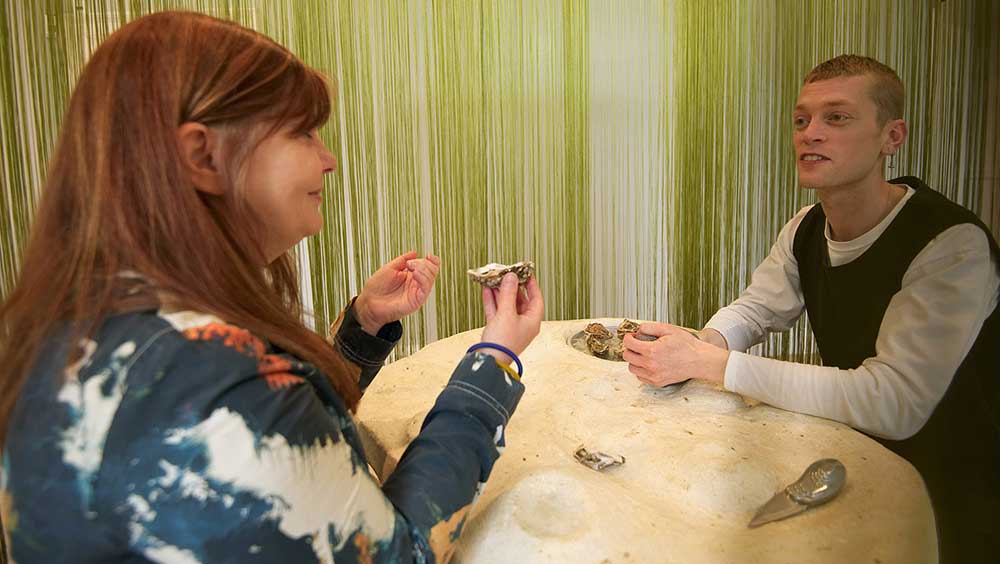
Cooking Sections and Sakiya: In the Eddy of the Stream, Inverleith House, Royal Botanic Garden Edinburgh, 2022. Photo: Shannon Tofts.
Inverleith House, Royal Botanic Garden Edinburgh
2 July – 18 September 2022
by JANET McKENZIE
In the Eddy of the Stream presents the art of two collectives: 2021 Turner Prize nominees Cooking Sections from Scotland and Sakiya from Palestine. The work, which is part of the Royal Botanic Garden Edinburgh’s Climate House exhibition programme and a partner exhibition of the Edinburgh Festival 2022, involves projects dedicated to historical damage that has culminated in the present day ecological crisis.
Cooking Sections and Sakiya create their own eddies – sheltered areas where water flows against the current, in order to propose a new understanding of the environment and the damage humans have done. Cooking Sections comprises two architecturally trained artists, Daniel Fernández Pascual and Alon Schwabe, who met at Goldsmiths, University of London and now live in the capital. They pose urgent questions for the 21st century: where does the food we eat come from? How is it produced? Food is used to explore, trace and advance climate justice. Using site-responsive installations and performance, they seek to improve understanding, establish common ground and push boundaries between art, architecture, ecology and geopolitics. Their large spatial drawing, in the room Intertidal Polyculture 2022, illustrates the need to think outside orthodox systems. Using handmade twine from natural materials, the wall and window (metal) pieces assert conceptual lift off from the picture plane, a metaphor to urge the viewer, the community and politicians to take the leap of faith for the sake of the environment and humanity’s future.
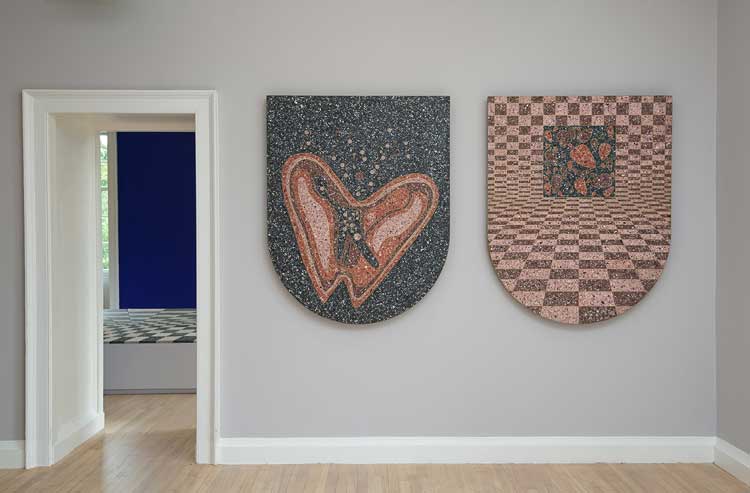
Cooking Sections and Sakiya: In the Eddy of the Stream, Inverleith House, Royal Botanic Garden Edinburgh, 2022. Photo: Shannon Tofts.
Cooking Sections’ research for Climate House is the product of a collaboration with Dr Chris Ellis at the Royal Botanic Gardens Edinburgh (RBGE), together with horticulturalists and archivists there, to identify the interdependence between wild salmon and forests in Scotland. Their research traces marine nitrogen carried by Atlantic salmon to pine trees adjacent to salmon breeding grounds. The contribution of salmon to the supply of marine nutrients is exciting in terms of future experimentation for cleaner and better ways to produce the essential food.
Emma Nicolson, head of creative programmes at the RBGE and curator of In the Eddy of the Stream, describes the critical and imaginative ways in which artists can present scientific material to enable us to comprehend the relationship between art and science. “Showcasing everything from sculptural works through plants, oysters, fish scales, tree cores and moor grass to never-before-seen materials, as well as performance, the exhibition highlights how alliances between humans and plants can also enhance new collective horizons,” she says.
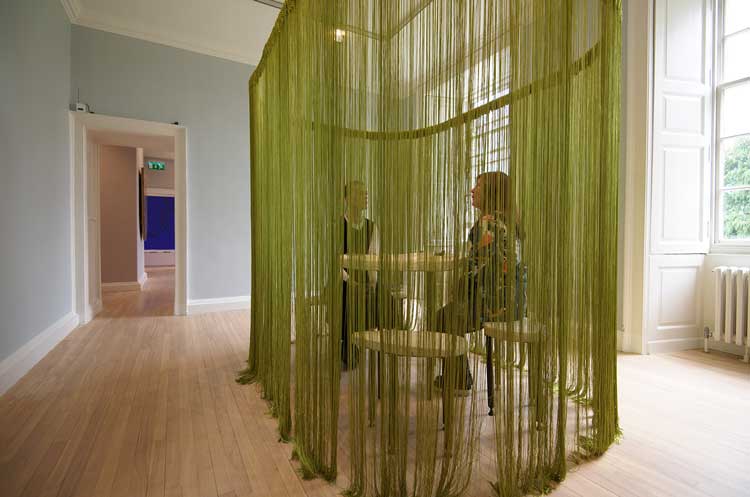
Cooking Sections and Sakiya: In the Eddy of the Stream, Inverleith House, Royal Botanic Garden Edinburgh, 2022. Photo: Shannon Tofts.
One of the most intriguing pieces in the show is Oyster Readings, which expands the work Cooking Sections have been doing on the Isle of Skye since 2016. Oyster Readings are a form of fortune telling where nature can be seen to hold the clues to the future. Using the humble oyster shell as a lens through which to view the natural world is an impactful experience. The artists explain: “One of the main protagonists in our exhibition are oysters that have populated the waters of Scotland for millennia, nourishing coastal people. Like a modern palimpsest, oysters record time and events. Similar to tree rings, every season an oyster grows a shell around its lip. As the shell grows, it encases the environmental conditions in which it lives. Oysters tell stories about storms and droughts, the health of oyster beds in the Firth of Forth, the proliferation of Edinburgh’s oyster cellars and the infamous Oyster Club; they also remember oil spills, and more recently, the effects of global pandemics. During the exhibition, the public is invited for an oyster reading, where the future of the Scottish coastline will expose itself through the surface of an oyster shell.”
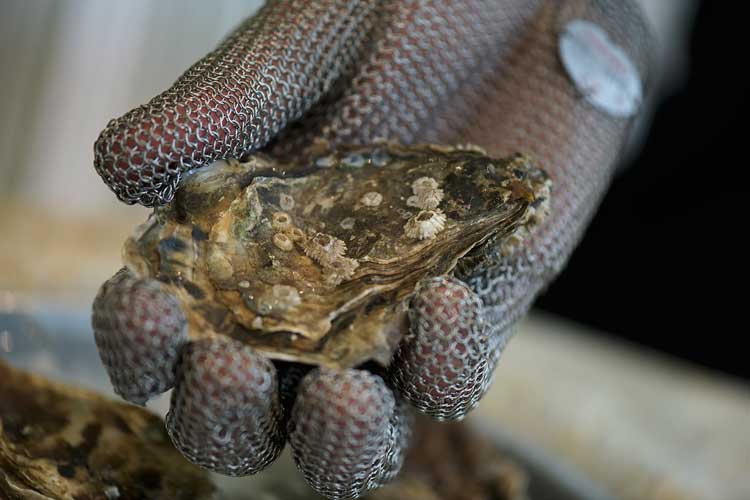
Cooking Sections and Sakiya: In the Eddy of the Stream, Inverleith House, Royal Botanic Garden Edinburgh, 2022. Photo: Shannon Tofts.
The Palestinian art collective Sakiya explores the role of plants in connection to land struggles, and the manner in which the British colonial regime in the early 20th century removed numerous plants, classifying them as weeds, irrespective of the fact that the Palestinians valued them for their nutrients and traditional healing properties. Sakiya is an academy, a residency programme, a research hub and a farm in a small agricultural village seven kilometres west of Ramallah, in Israeli-occupied Palestinian territory. By grafting local traditions of self-sufficiency on to contemporary art and ecological practices, Sakiya seeks to create new narratives around relationships to land, knowledge-production and commoning.
The exhibition addresses the breakdown of ecosystems through the removal of indigenous species of plants where their removal destroys the long-term alliances between plants and human lives, necessities such as medicinal plants and indigenous food production. Further, the wide range of works in the exhibition challenge how botany has been used as a means of asserting political land division. The banning of foraging, for example, reflects land ownership control; rewilding seeks to relax the overproduction of crops that causes soil degradation.
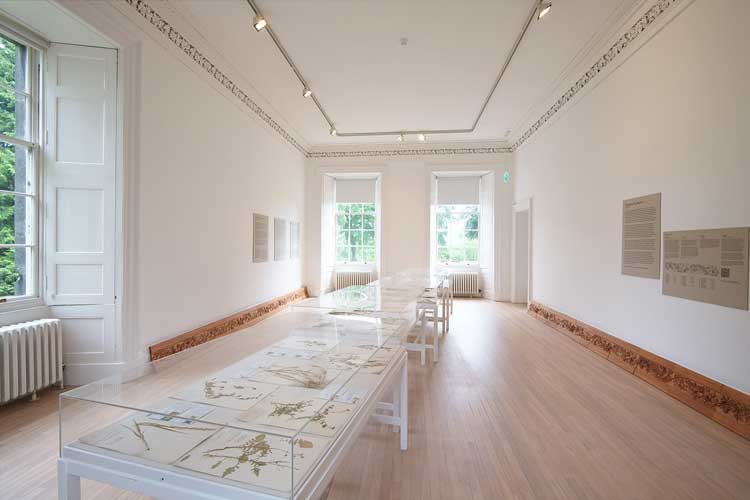
Cooking Sections and Sakiya: In the Eddy of the Stream, Inverleith House, Royal Botanic Garden Edinburgh, 2022. Photo: Shannon Tofts.
Sakiya states: “As part of our practice to challenge botanical imperialist practices of taming the wild, green washing, western classification systems, erasure of plants, stories and practices, and modernist notions of agricultural productivity, we present 33 weeds that were brought under attack during the British Mandate period in Palestine. Through a communal practice to identify historic and new botanical imaginaries, stories will be collected and composed in Palestine about these 33 weeds throughout the exhibition period and sent to the Climate House to be presented alongside the original weed pressings found in the RBGE archive. We are happy to connect in solidarity with global collectives such as Cooking Sections, working on issues of environmental justice, challenging colonial practices, and building communing strategies for alternative imaginaries to organise, live and work together.”
Under the Tree (2022) mimics the original plasterwork on the ceiling at Inverleith House (built in 1774), with beautiful carving on to wood to form a baseboard. The original moulding, a Greco-Roman design using vine leaves and grapes, is echoed at ground level by the flip side of desirous plants, but those that represent the struggle for freedom and political power. Under the Tree refers to what is hidden under the forests planted in Palestine under British Mandate, namely the traditional biodiversity and valuable species such as the Mount Tabor oak that the British replaced with pine forests. Sakiya’s installation mourns the loss of the oak trees’ indigenous habitat, which is now vulnerable to disease and fire.
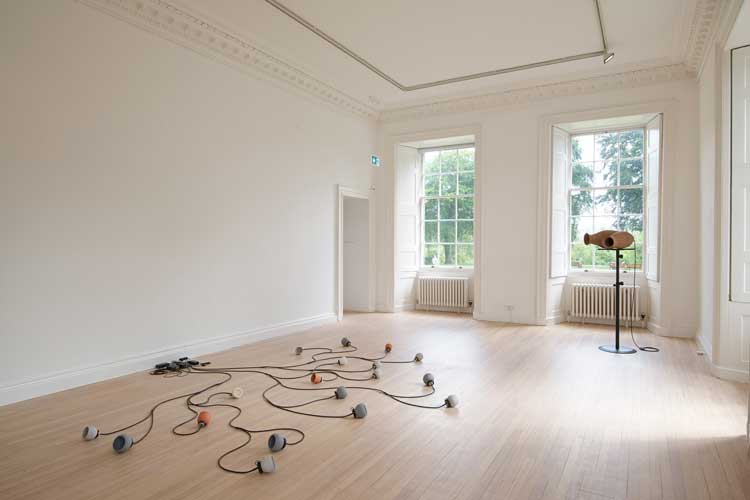
Cooking Sections and Sakiya: In the Eddy of the Stream, Inverleith House, Royal Botanic Garden Edinburgh, 2022. Photo: Shannon Tofts.
Recalling Recollection (2022) presents weeds as exiles, yet the collective also presents them as caretakers, for their capacity to heal the soil. Edinburgh Festival-goers might identify a parallel with the work of Joseph Beuys, one of the most influential artist activists of the late 20th century, whose work has been presented at numerous Edinburgh Festival events over the past 50 years. Richard Demarco, who invited Beuys to Scotland in the 70s, said that of all the places in the British Isles that Beuys might have gone, it was Scotland with its ancient landscape and mystery that he chose to visit and work in. Further, Demarco explains: “Beuys’s art exhorts us ‘to show our wounds’ and to use the language of art as a blessing upon the suffering of humanity and as a message of hope.”1
Sakiya and Cooking Sections’ controversial campaigns using a unique range of natural phenomena as protagonist (weeds, mussels, fish, oysters, forests) to highlight damage to ecosystems, have found an inspiring Beuysian sense of place at the Edinburgh Festival, where his work has been showcased since the 1970s. At this year’s Biennale of Sydney: Rīvus, Joseph Beuys’s 7,000 Oaks: City Forestation Instead of City Administration (1982), which included a Sydney iteration with the planting of a Moreton Bay Fig (1984), was memorialised with a performance piece by Mike Parr. Edinburgh’s Fringe Festival, too, since its inception in 1947, seeks to question conventional orthodoxies in the arts, to address wider universal issues. Cooking Sections draw attention to the relationship between water and politics, water stress in the environment, soil exhaustion, chemical damage and subsequent damage to fish from antibiotics, disease and parasites through their research into a “salmon breeding forest”, no less. The conceptual structures prompt the visitor to address notions of appearance and reality (delicious versus pollutant). The work on show has evolved from their Climavore project, which started in 2016 on the Isle of Skye in Scotland’s Outer Hebrides, highlighting the dire pollution produced by Scottish salmon farming.
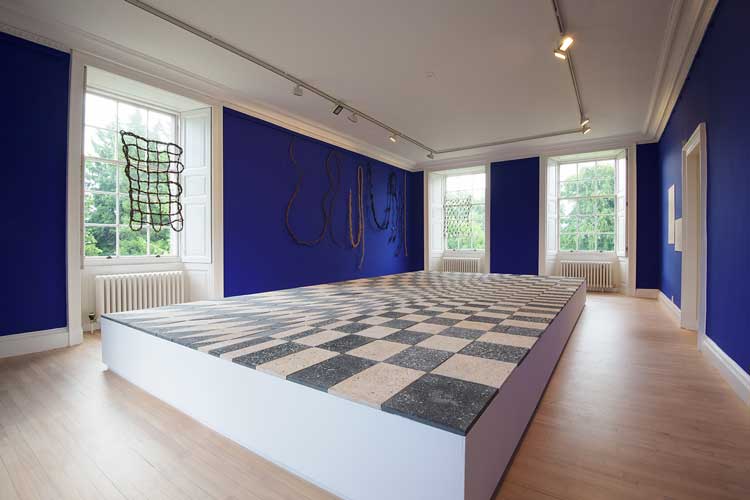
Cooking Sections and Sakiya: In the Eddy of the Stream, Inverleith House, Royal Botanic Garden Edinburgh, 2022. Photo: Shannon Tofts.
Nicolson was the first director of Atlas Arts,2 where she identified Cooking Sections’ unique vision. Climavore explored ways in which the ocean can be regenerated, by way of the creation of new seaweeds and sea vegetables. These, in turn, can be cultivated to improve depleted soils and water and marine habitats. Farmed salmon, they insist, must be replaced with wild salmon to nurture marine habitats and the seashores.
Cooking Sections invited Sakiya to join them for In the Eddy of the Stream, their first exhibition in the UK: “The exhibition at Climate House has been a great opportunity to interlink botanical struggles between Scotland and Palestine. It’s a culmination of a three-year research process with scientists, botanists and researchers that expands the work we have been doing in Skye since 2016. We are excited to exhibit along[side] Sakiya, who have been a source of inspiration in the way they work critically across heritage, food, farming, art and culture to reimagine relations between people and their surroundings under the occupation. But more importantly, how to open up new horizons from the ground up.”
In the Eddy of the Stream is a thought-provoking original contribution to the ecological crisis, a unique collaboration between artists, scientists and researchers.
References
1. Joseph Beuys: Actions, Vitrines, Environments by Richard Demarco, Studio International, 2005.
2. Atlas Arts is a visual arts organisation dedicated to commissioning contemporary arts, culture, heritage, and education based in the Isle of Skye.